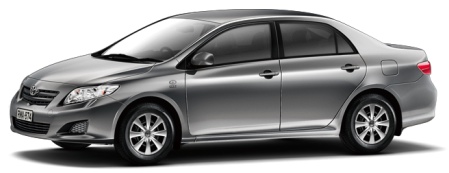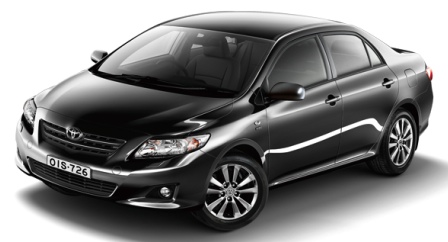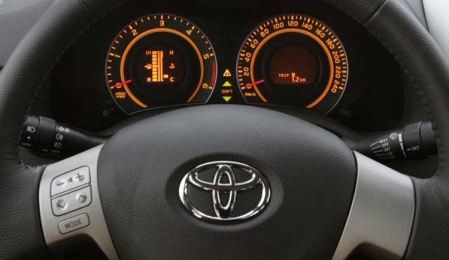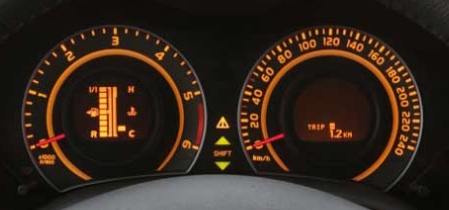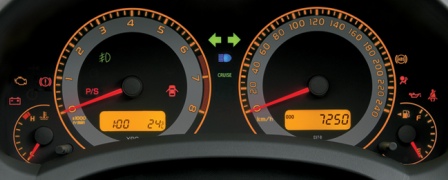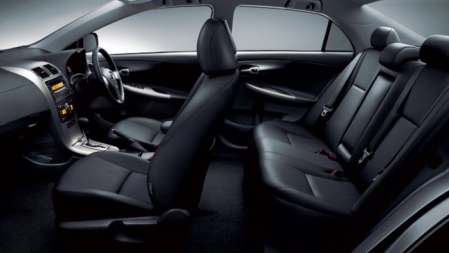Toyota Corolla T-Sport v Peugeot 307 HDI XSi v Honda Civic Type-R v Fiat Stilo Abarth v Peugeot LAD 205 GTIHot Hatch Group TestHot hatches are losing the plot. Discuss, with the help of four new-wave hatchbacks from Fiat, Honda, Peugeot and Toyota... and a re-made Peugeot 205 GTIText: John Barker / Photos: Andy MorganMarch 2002You're invited to a party. It's a biggie, a landmark, the big three-o, but don't go and panic buy a naff card from a filling station because it's not until 2006 and, to be honest, we're not sure whether we'll be celebrating the GTI's health at 30 or mourning its demise.
Right now, the prognosis doesn't look rosy. Since Volkswagen created the original, the Golf GTI, back in 1976 and spawned a host of imitators, there have been other worrying times. Most notably there was the insurance blight of the early '90s, which escalated premiums, scared off a number of the big players and reduced choice for a few years. However, the current crisis looks less likely to blow over because it's the very fabric of the hot hatch that is under threat.
The recipe for the GTI has always been a straightforward one: take a simple, smallish, front-drive family hatch, give it a gutsier engine, sharpen up the handling and garnish with huggy seats, alloy wheels and a spoiler or two. Result: a nippy, nimble and affordable little driver's car with useful practicality.
It's the way hot hatches are still made today, except that the major ingredient, that simple family hatch, isn't so simple any more. Nor is it so small. The evolution of the Golf illustrates this, as you can see from our graph. Each generation has been more powerful than its predecessor but also bigger and heavier, too. Although the Golf's power-to-weight ratio (a sound indicator of how fast a car will feel in a straight line) hasn't changed significantly, the physical size and mass of the growing Golf has made it less wieldy, less GTI-like. It's why hot Golf purists recognise the original and the 16-valve Mk2 as the best there have been.
This up-sizing isn't just confined to VW, of course. Car buyers (or is it just marketeers?) demand that each new version of a mass market hatchback is more spacious, more fully equipped, more everything than the last. The GTI model is an innocent victim, in thrall to the basic car, and it counts for little that in the past it has accounted for a substantial percentage of the model's sales and lent the range enormous credibility.
The current Golf finds itself behind the times, though. In the last year or so the market has shifted again, and the change is well illustrated by the Car of the Year 2002, the Peugeot 307. Like architects of the '60s, hatch designers have realised there's more space available if you build upwards. Innovator Renault can probably take some of the credit for this ΂- its Megane Scenic sent a seismic jolt through the industry and the after-shock is a clutch of semi-MPV hatch designs: 307, Fiat Stilo, Honda Civic and Toyota Corolla. They all dwarf the 205 GTI we've brought along.
Market analysts predict that the family saloon, as epitomised by Mondeo/Vectra, will become less popular and when you've loafed around in these new hatches you can see why ΂- they're almost as roomy. Space isn't high on a GTI driver's wish list, though, and this new form of hatch sits its driver higher and thus further away from the action, as well as being Golf-heavy and casting a similar-sized shadow.
But is it all bad? Perhaps not. The art of chassis design and tuning has come a long way since the heyday of the 205 and even the Renault Clio Williams and 306 GTI-6. Clever manipulation of geometry, achieved in part through increasingly sophisticated suspension mounting bushes, can be proven by computer simulation even before the car has turned a wheel, and hands-on development engineers can then further refine it. Then there's the basic body structure, whose stiffness ΂- vital to good suspension control ΂- can be predicted and improved on computer. And, of course, there's engine development. Two of our contenders boast power outputs in excess of 180bhp, lifting their power-to-weight ratios way beyond that of the current Mk4 Golf GTI.
The 307 isn't one of them. Peugeot may be a major player on the World Rally scene and have an enviable reputation for great GTIs but we've yet to see the long-rumoured, really hot 206 GTI and the quickest 307 has just 138bhp. The others are giving it their best shot, though. Top dog in the new Stilo range is the sexy looking three-door Abarth with a 170bhp 2.4-litre five-cylinder motor and compulsory-fit Selespeed semi-manual gearbox. The Civic Type-R we know well ΂- screaming 197bhp four-pot engine mated to a six-speed manual ΂- and so too, it seems, does Toyota. The on-paper specification of its new Corolla T-Sport is similar to the Type-R's, only here the power produced at stratospheric revs is a fractionally less impressive 187bhp.
Can this new breed of hatch be fun? That's what we've set out to answer, with the help of the 205 GTI 1.9, one of the all-time great hot hatches. It looks like an unfair comparison ΂- when Peugeot was concocting the 205 GTI it knew that the Mk2 Golf was going to be bigger and heavier, thus gifting it a niche, so to compare it with the even bigger Mk4 Golf's rivals is stretching a point. On the Pug's side, it is now 15 years since it was launched, so how can it hope to be representative of an as-new example? That's one of the reasons it's here ΂- there is a company making a tidy business out of refreshing 205 GTIs for owners who can't find anything more desireable or as good value for money.
For around ΂£5000, all in, LAD Motorsport will undertake to track down a tidy 1.9 GTI and then give it a thorough overhaul so that it's 'good for another 80,000 miles'. This includes stripping and rebuilding the engine, gearbox and rear beam axle, uprating the front springs, fitting bigger front discs and new rear discs, rebuilding the gear linkage with a slightly shorter throw, touching up the paintwork and refurbishing the wheels. It's an idea that has clearly struck a chord ΂- since July last year, LAD has delivered 20 such cars and has orders for another three.
It's been a few years since I last drove a 205 and as I step into this one, survey the copious painted metal and cheap fittings (the facia looked brittle and low-rent when it was new), I wonder if the Peugeot really is as good as I remember it. This car also has a huge rear 'silencer', which some might find appealing but which introduces severe boom periods and doesn't seem to do anything for the performance. It's well known in tuning circles that the standard 205 GTI exhaust is very hard to beat and LAD recommends that it is retained.
After a few miles, the 205 has charmed me. There's a certain magic about it ΂- it's not any one thing but the way the whole car seems to fuse together as a focused, cohesive and fun package. The fizzy, willing engine and the wristy gearshift that's so fast it slots the next gear before the revs have had a chance to die; the ride that's firm but also remarkably supple, and, of course, the way it tackles corners. You'd think that the 205 came from a planet that didn't have any straights. It makes such light work of B-road bends, tucking in roll-free and hauling out under full power in one fluid, effortless motion. Low inertia, great poise and just the right amount of rubber (mere 185/55 VR15s) are the keys. It's hard not to get carried away by the zesty energy of the thing, but you do have to be aware that this agility is partly due to a light and mobile rear end. Lift-off oversteer can be very useful, so long as you don't push it too far.
Of course all four new hatches here are going to feel big and heavy in comparison, but the 205 is here as a refresher, a reminder of how a hot hatch should be. The best that followed ΂- Renault Clio Williams and 306 GTI-6 ΂- were variations on this theme, though it's worth noting that the 306 was no lightweight at 1199kg for the pared-down Rallye version.
It quickly becomes apparent that the Stilo and Corolla are quite ordinary chassis-wise. The best you can say about the Toyota is that it has a good ride. It never feels poised or focused, never feels like a GTI, and that headline-grabbing engine hides all its power away at the very top of its rev range. It's often caught floundering around in the mid-range and even when you do tap into the power band, it's a struggle to keep there, even with six gears to choose from.
Fire up the Stilo and it instantly has more charisma than the Corolla thanks to its creamy, warbly five-pot motor. It lugs reasonably hard but feels smothered, while on a decent B-road the Stilo's suspension seems to take two bites at every bump, almost as if its optional 17in smoke- chrome alloys and 215/45 P7000s are too heavy for the dampers. This feeds back to the steering, which jiggles in your hands, though if the corner is smooth the nose really digs in and hooks the apex with conviction. Sadly these are infrequent glimpses of how good the Stilo could be, and how good you want it to be when you first walk around it, key in hand, taking in its sharp, folded- paper looks.
We didn't mention its Selespeed transmission, but when you've got one of the snappiest six-speed manuals in production to compare it with, it's best not to. Of all the things the Civic Type-R gets right, that initially odd-looking lever sprouting from the facia tops the list. It draws attention to the fact that you're sitting tall, then confounds your expectation by working beautifully. What also help to get you in the groove are the hip-hugging seats, chunky wheel and white-faced dials.
There's no question the Civic was meant to be driven hard. Once you've entered the VTEC zone and felt the surge, you make it your mission to keep it there, and you can. The 205 could keep the Corolla and Stilo at bay, but the Civic on a roll slaughtered it. The more sensitive Type-R owners might feel that's damning with faint praise but I'd add that the Civic left the 205 through the corners, too. However, as we've said before, the Honda would be even more enjoyable if its steering had a more natural feel and its chassis a little more poise and adjustability. It's effective, sure, but the fun of cars like the 205 and the old Integra Type-R is the way they seem to enjoy the corners, their sensitivity.
Still, there's no other new-wave hatch that can touch the Civic for sheer driver appeal, is there? Well, the 307 could spoil its party, but not yet. With just 138bhp, it simply doesn't have the firepower to come alive. In fact the car we used for this photoshoot was the even tardier 110bhp HDi turbodiesel, which is not only heavier (1296kg versus 1219kg for the petrol) but packs most of it on at the front.
Not a good omen for agility, and yet...
After a run of decidedly average chassis (406 Coupe, 206 GTI, 607), Peugeot seems to have rediscovered the knack. Even in diesel form the 307 has balance, fluidity and responsiveness. Turn it into a corner and it seems to pivot about a point just below the gearlever. Marvellous. But you sit tall, it feels heavy and wide, and it can't change direction with real crispness despite 17in rims and generous 205/50 helpings of Pirelli's finest. Even so, if only Peugeot would pull its finger out and get that 180bhp engine under its bonnet, it could create a real driver's car.
The best-selling hot hatch of the last five years has been the Citro΃«n Saxo VTR/VTS and it's a fine little car, though we rate its cousin, the 106 GTI, as the best baby hatch you can buy for pure driving thrills. Saxo and 106 are even more compact than the 205 and overdue for replacement, but the question is by what? A bit more space wouldn't go amiss but so far all we've seen to give us any hint of what might come next is the Citroen C3, a rounded, tall little car...
We still have the Clio 172, of course, a car that carries the genes of the R5 Turbo and Clio Williams. It's only a couple of years old so it'll be around for another three years or so. What replaces it is hard to predict now that Renault is getting radical again with Vel Satis and Avantime. Let's hope that Renault remembers its own slogan ΂- 'Size Matters'.
It would be premature to write off the GTI as we know it, though. It's a formula that still has plenty of mileage left in it because not everyone wants to drive a high-rise. If you feel like you need cheering up, you could always nip out and buy that 30th birthday card, ink 2006 into your diary and invoke the power of positive thinking. Or you could turn the page and see what's coming your way very soon.
Source:
http://www.evo.co.uk/carreviews/cargrouptests/19454/toyota_corolla_tsport_v_peugeot_307_hdi_xsi_v_honda_civic_typer_v_fiat_stilo_abarth_vpeugeot_lad_205_gti.html






